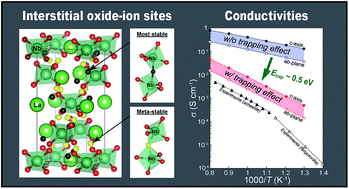Oxide-ion conduction via interstitials in scheelite-type LaNbO4: a first-principles study
Abstract
Interstitial oxide-ion conduction in tetragonal scheelite-structured oxides has theoretically been analyzed using first-principles calculations, taking lanthanum niobate (t-LaNbO4) as a model system. In the crystal, two interstitial sites of oxide ions were identified by exhaustive structural optimizations, which are located between two NbO4 tetragonal units to form an Nb2O9 unit. Among the four elementary paths found by the nudged elastic band method, the three common paths enable interstitial oxide ions to migrate over a long range both in the ab-plane and along the c-axis, leading to the almost isotropic oxide-ion conductivity. However, the oxide-ion conductivities estimated on the basis of the kinetic Monte Carlo method were much higher than the reported experimental values. The apparent activation energies were also different, ∼0.4 eV in the estimated conductivities vs. ∼0.9 eV in the experimental conductivities. As a result of additional evaluation of the trapping effect by dopants, interstitial oxide ions were found to be strongly trapped by W dopants on La sites. The corrected oxide-ion conductivity was drastically reduced by the trapping effect, finally to be in reasonable agreement with the experimental conductivities.



 Please wait while we load your content...
Please wait while we load your content...